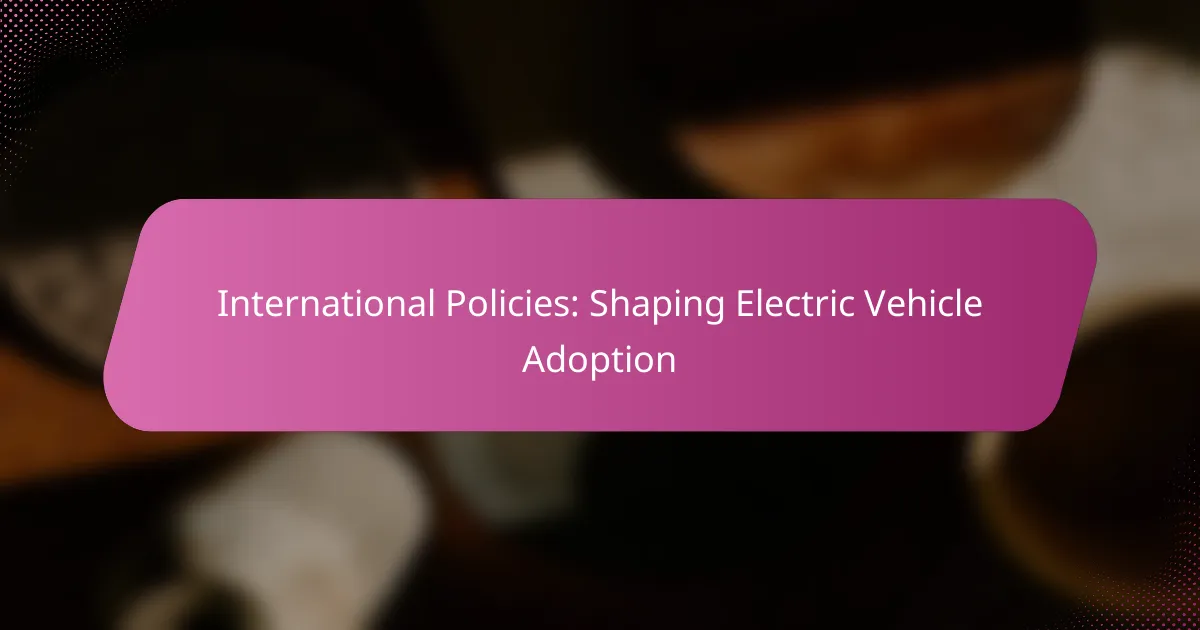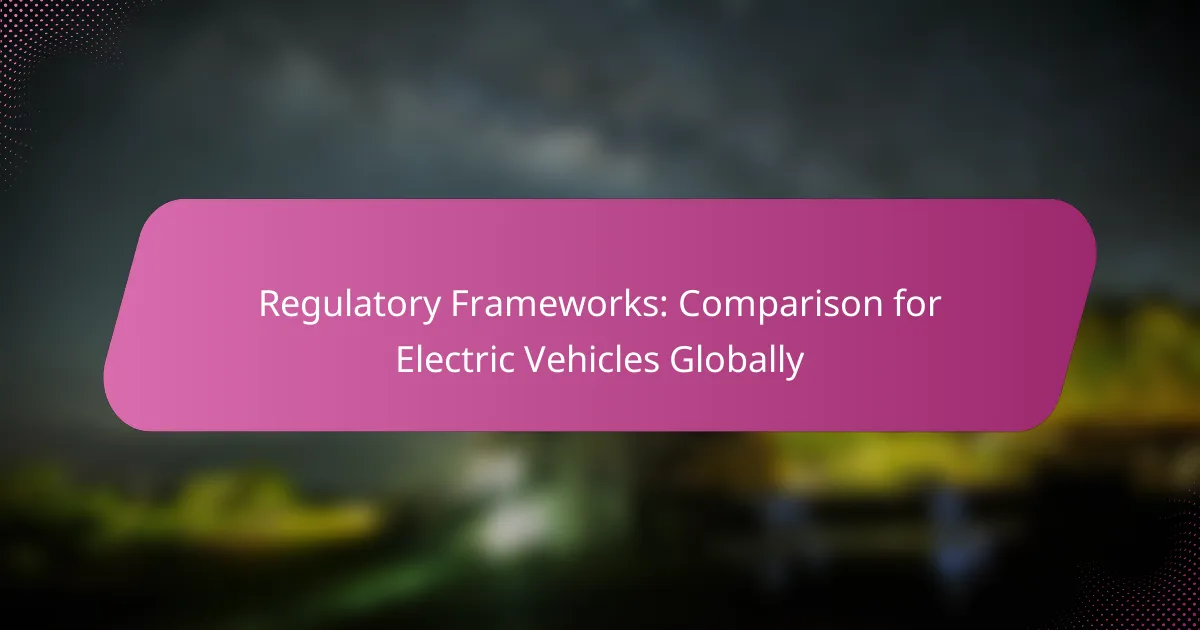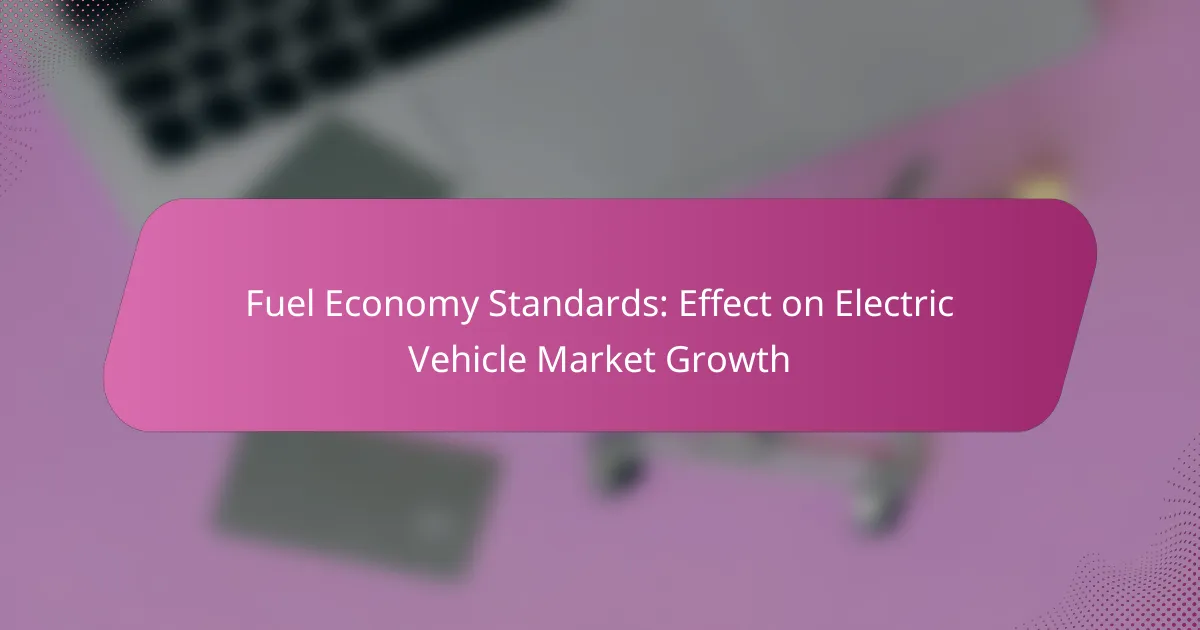International policies play a crucial role in shaping the adoption of electric vehicles (EVs) by establishing frameworks that promote sustainability and reduce emissions. Initiatives such as the European Green Deal and various tax incentives in North America encourage consumers and manufacturers alike to transition towards cleaner transportation solutions. By setting stringent emissions regulations and providing financial benefits, these policies facilitate the growth of the EV market and support the development of innovative technologies.
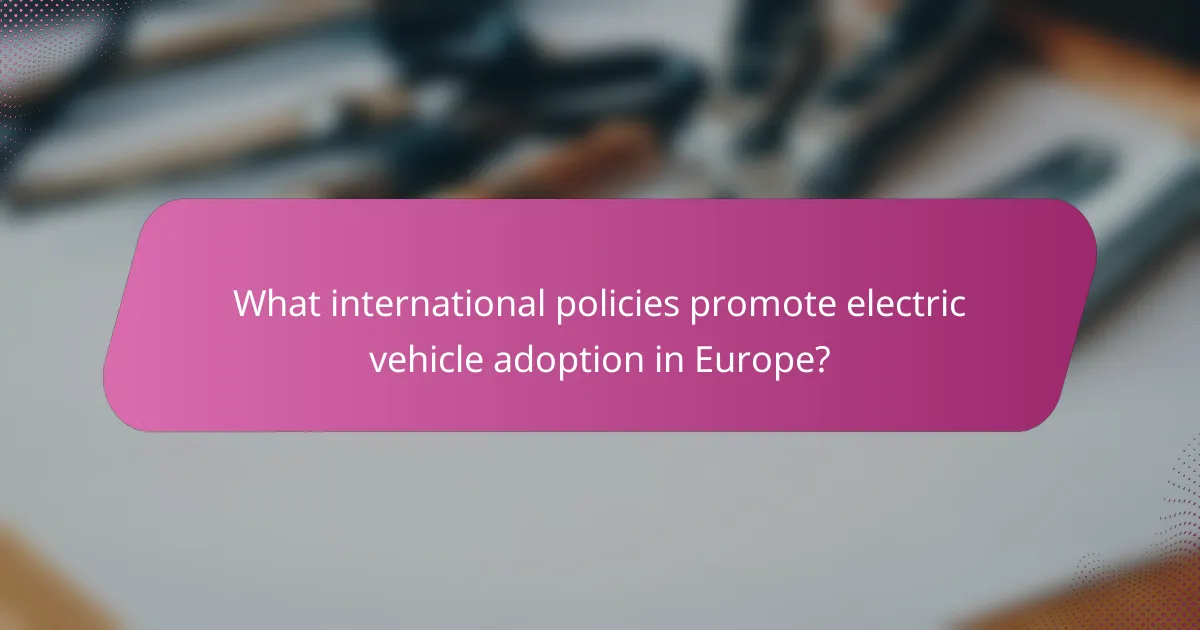
What international policies promote electric vehicle adoption in Europe?
International policies in Europe that promote electric vehicle adoption include comprehensive frameworks aimed at reducing emissions and enhancing sustainability. Key initiatives such as the European Green Deal and the Fit for 55 Package set ambitious targets, while national incentive programs and infrastructure investments further support the transition to electric mobility.
European Green Deal
The European Green Deal is a cornerstone policy aimed at making Europe the first climate-neutral continent by 2050. It includes measures to reduce greenhouse gas emissions, promote clean energy, and enhance biodiversity, which directly impacts electric vehicle (EV) adoption by encouraging cleaner transportation options.
Under this deal, the EU aims to cut emissions by at least 55% by 2030 compared to 1990 levels, significantly boosting the demand for electric vehicles as part of a broader shift towards sustainable transport solutions.
Fit for 55 Package
The Fit for 55 Package complements the European Green Deal by outlining specific legislative proposals to achieve the 55% emissions reduction target. This package includes revisions to existing regulations and introduces new measures that incentivize the adoption of electric vehicles.
Key components include stricter CO2 emissions standards for cars and vans, which push manufacturers to increase their electric vehicle offerings, thereby making EVs more accessible and appealing to consumers.
National Incentive Programs
Many European countries have implemented national incentive programs to encourage electric vehicle adoption. These programs often include financial incentives such as grants, tax reductions, and rebates for both consumers and manufacturers.
For example, countries like Germany and France offer substantial subsidies that can cover a significant portion of the purchase price of electric vehicles, making them more affordable for the average consumer.
Zero Emission Vehicle Mandates
Zero Emission Vehicle (ZEV) mandates require automakers to sell a certain percentage of electric vehicles within their total sales. These mandates are designed to accelerate the transition to electric mobility by ensuring that a growing share of new vehicles are zero-emission.
Countries like Norway have set ambitious targets, aiming for all new cars sold to be zero-emission by 2025, which has led to a rapid increase in electric vehicle market share.
Charging Infrastructure Investments
Investment in charging infrastructure is critical for supporting electric vehicle adoption across Europe. Governments and private entities are collaborating to expand the network of charging stations, making it easier for consumers to transition to electric vehicles.
Many countries are setting targets for the number of charging points per capita, with initiatives to install fast chargers along major highways and in urban areas, ensuring that charging is convenient and accessible for all EV users.

How do tax incentives influence electric vehicle sales in North America?
Tax incentives significantly boost electric vehicle (EV) sales in North America by reducing the overall purchase cost for consumers. These financial benefits encourage more buyers to consider EVs, thus accelerating the transition to cleaner transportation.
Federal Tax Credit in the USA
The federal tax credit for electric vehicles in the USA can provide up to $7,500 off the purchase price, depending on the vehicle’s battery capacity and the manufacturer’s sales volume. This incentive is designed to make EVs more affordable and appealing to a broader audience.
To qualify, buyers must purchase a new EV and meet certain criteria, including income limits. It’s essential to check the current eligibility requirements, as they can change based on legislation and the specific model of the vehicle.
Provincial Incentives in Canada
In Canada, provincial governments offer various incentives to promote electric vehicle adoption, which can range from rebates to tax credits. For example, provinces like Quebec and British Columbia provide substantial rebates that can lower the cost of an EV by several thousand Canadian dollars.
These incentives often vary by province, so potential buyers should research local programs to understand the specific benefits available in their area. Additionally, some provinces may have special programs for low-income households to further encourage EV adoption.
State-Level Rebates
Many U.S. states offer their own rebates and incentives for electric vehicle purchases, which can complement the federal tax credit. States like California and New York provide additional financial benefits, sometimes exceeding $2,000, to encourage residents to switch to electric vehicles.
It’s crucial for buyers to explore state-specific programs, as eligibility and amounts can differ widely. Some states also offer incentives for home charging station installations, enhancing the overall value of transitioning to an electric vehicle.
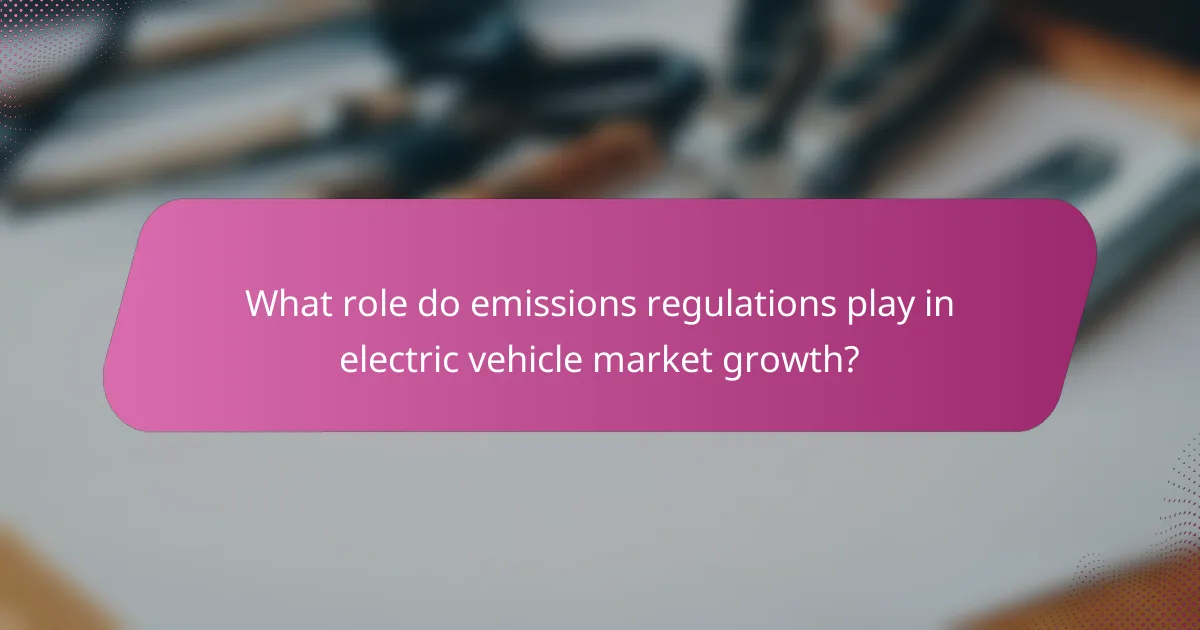
What role do emissions regulations play in electric vehicle market growth?
Emissions regulations significantly influence electric vehicle (EV) market growth by setting standards that manufacturers must meet to reduce greenhouse gas emissions. These regulations create a framework that encourages the development and adoption of cleaner technologies, including EVs, by imposing penalties for non-compliance and offering incentives for meeting or exceeding targets.
Corporate Average Fuel Economy Standards
Corporate Average Fuel Economy (CAFE) standards are regulations in the United States that require automakers to achieve a specified average fuel economy across their fleet of vehicles. These standards push manufacturers to innovate and produce more fuel-efficient vehicles, including electric models, to meet compliance and avoid fines.
As CAFE standards tighten, automakers are increasingly investing in electric vehicles to offset the emissions from their gasoline-powered cars. This shift not only helps manufacturers meet regulatory requirements but also aligns with consumer demand for greener options.
EU Emissions Trading System
The EU Emissions Trading System (ETS) is a cap-and-trade framework aimed at reducing greenhouse gas emissions across Europe. Under this system, companies receive or buy emission allowances, which they can trade based on their performance in reducing emissions. This creates a financial incentive for companies to lower their carbon footprint, including transitioning to electric vehicles.
By participating in the ETS, automakers are motivated to increase their production of electric vehicles, as these vehicles typically have lower emissions compared to traditional combustion engines. The financial implications of the ETS can lead to significant investments in EV technology and infrastructure, further accelerating market growth.
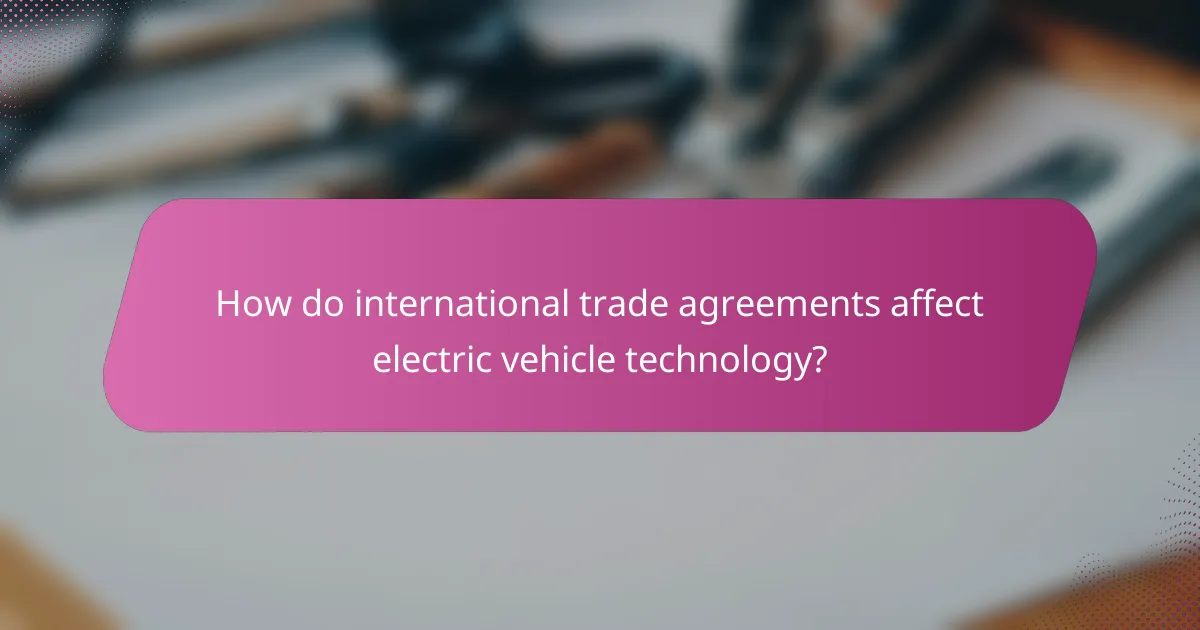
How do international trade agreements affect electric vehicle technology?
International trade agreements play a crucial role in shaping electric vehicle (EV) technology by influencing tariffs, standards, and supply chains. These agreements can either facilitate or hinder the adoption of EVs based on the regulations they establish for components and technologies involved in their production.
USMCA and EV Components
The United States-Mexico-Canada Agreement (USMCA) has specific provisions that impact the production of electric vehicle components. It encourages North American manufacturing by requiring a certain percentage of EV parts to be sourced from within the region, which can reduce tariffs and promote local jobs.
For example, under USMCA, automakers must ensure that at least 75% of the value of an EV’s components is produced in North America to benefit from tariff-free access. This requirement can lead to increased investment in local supply chains, fostering innovation in EV technology.
EU-China Trade Relations
The trade relationship between the European Union (EU) and China significantly affects the electric vehicle market, particularly in terms of battery technology and raw materials. China is a major supplier of lithium-ion batteries, which are essential for EVs, and the EU relies on these imports to meet its growing demand for electric vehicles.
Recent trade tensions have prompted the EU to consider strategies to reduce dependency on Chinese battery supplies. This includes investing in domestic battery production and establishing partnerships with other countries to secure raw materials, which could reshape the landscape of EV technology in Europe.
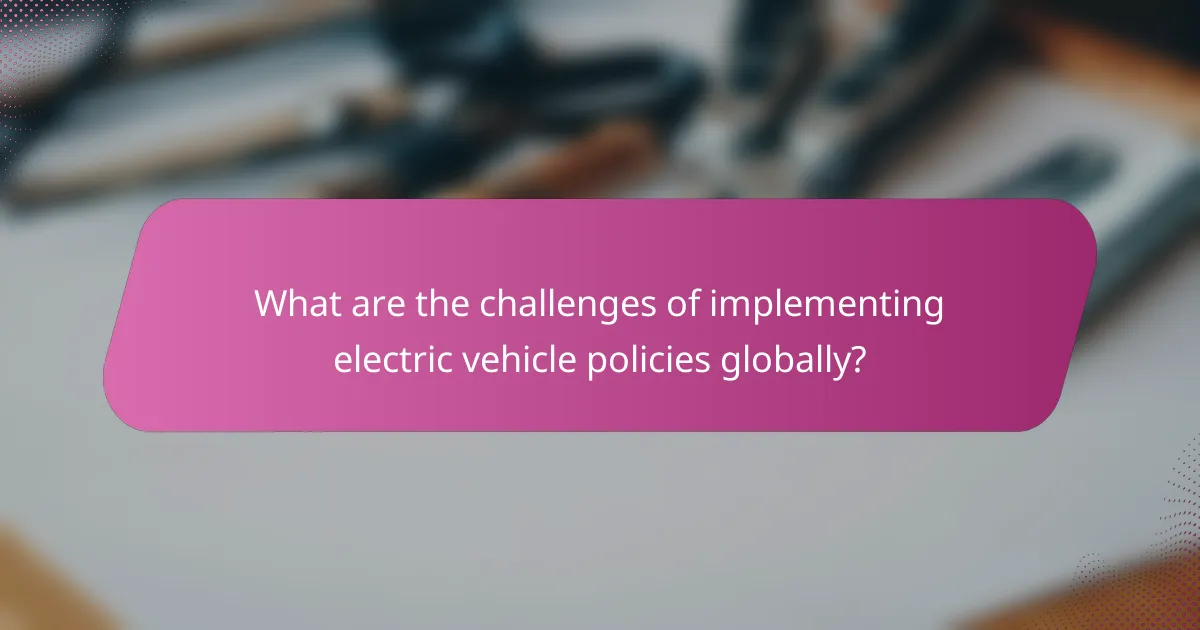
What are the challenges of implementing electric vehicle policies globally?
Implementing electric vehicle (EV) policies worldwide faces several significant challenges, including infrastructure development, consumer acceptance, and market fragmentation. These hurdles can hinder the effective adoption of EVs and the realization of their environmental benefits.
Infrastructure Development Issues
One of the primary challenges in implementing EV policies is the lack of adequate charging infrastructure. Many regions, especially rural areas, may not have sufficient charging stations, making it difficult for consumers to transition to electric vehicles. Governments need to invest in expanding charging networks to ensure accessibility and convenience.
Additionally, the electrical grid in many countries may require upgrades to handle increased demand from EV charging. This can involve substantial investment and planning, particularly in developing nations where infrastructure is already limited.
Consumer Acceptance Barriers
Consumer acceptance of electric vehicles is often hindered by concerns over range anxiety, the initial purchase price, and the perceived performance of EVs. Many potential buyers worry that EVs may not meet their daily driving needs or that charging times are too long compared to refueling traditional vehicles.
To overcome these barriers, policymakers can implement incentives such as tax credits or rebates to lower the upfront costs of EVs. Public awareness campaigns highlighting the benefits of EVs, including lower operating costs and environmental impact, can also help shift consumer perceptions.
Market Fragmentation
Market fragmentation poses a significant challenge for the global adoption of electric vehicles. Different countries and regions have varying regulations, incentives, and standards, which can complicate the manufacturing and distribution of EVs. This inconsistency can lead to confusion among consumers and manufacturers alike.
To address market fragmentation, international cooperation is essential. Establishing common standards for charging infrastructure and vehicle specifications can facilitate smoother market entry for manufacturers and improve consumer confidence in EV technology.
